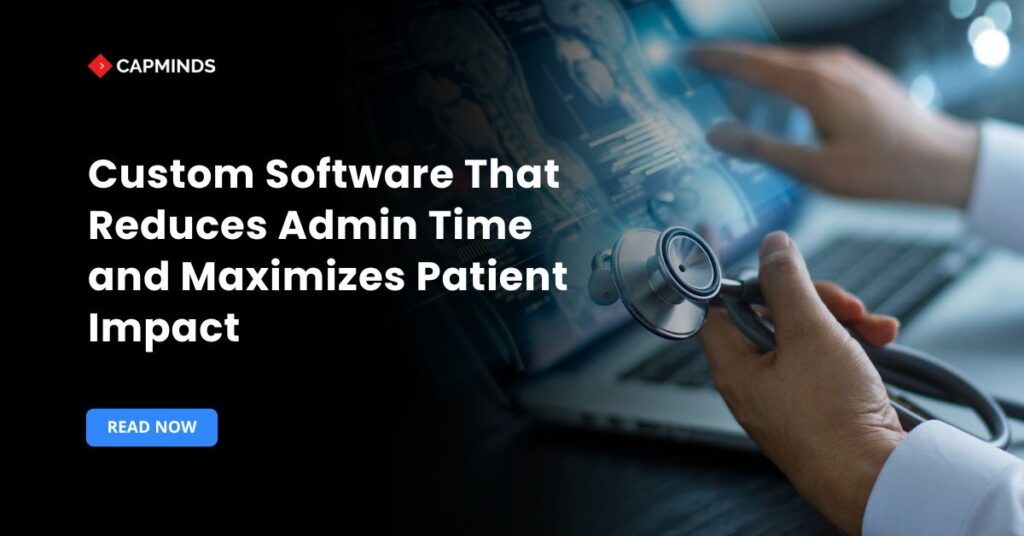Custom Software That Reduces Admin Time and Maximizes Patient Impact
Most clinicians can recall a late evening spent hunched over a system, finishing charts long after the last patient left. Paperwork has become the silent occupant of every exam room. Recent estimates place the administrative share of a physician’s day somewhere between one-third and one-half, time consumed by coding details, insurance queries, and tedious data entry. What should be short notes often stretch into page after page, edging out the minutes that make medicine personal.
The consequences are felt on both sides of the stethoscope. Providers head home exhausted, wondering whether they practised medicine or clerical work. Patients, meanwhile, notice appointments that start behind schedule and consultations that feel hurried.
Custom-built healthcare software offers a different path. Instead of forcing every clinic to squeeze into a generic platform, these tailored systems automate repeat tasks, surface the right fields at the right moment, and hand routine data transfers over to background processes. The effect is straightforward: less clicking, fewer duplicate forms, and more room in the schedule for hands-on care.
When administrative friction drops, the benefits add up quickly: shorter wait times, clearer records, and clinicians who finish the day focused, not frazzled. In the end, that reclaimed attention is what patients remember: a conversation that isn’t cut short and a care plan shaped by undivided expertise.
The Heavy Administrative Burden in Healthcare
Ask any nurse at shift-change or a physician reviewing charts after hours: paperwork no longer lives at the edges of care; it often sits right in the middle of it. Health records, insurance details, consent forms, referral notes: the sheer volume now dictates the pace of the day.
When these details are handled by hand, two patterns appear almost everywhere:
- Longer waits, shorter visits. A patient might spend 25 minutes in the waiting area because staff are searching for insurance pre-authorizations or re-keying demographic data for the third time.
- Staff stretched thin. The same clinician who just performed a procedure is back at a desk copying vitals into a second system because the first one cannot communicate to the billing platform.
Across care settings, that story repeats, with different twists:
- Hospitals. A medication order entered in the ward often has to be re-typed for pharmacy verification because the two modules don’t share a common field.
- Private practices. A three-person office loses an afternoon on hold with payers, leaving fewer appointments open and revenue unclaimed.
- Mental-health centres. Therapists juggle progress notes, outcome scales, and consent renewals, trimming client sessions to fit the paperwork.
The cost isn’t measured only in hours or dollars; it shows up in hurried examinations, missed eye contact, and clinician fatigue. When the administrative load swells, quality and patient satisfaction inevitably dip.
Purpose-built software can reverse that trend.
By automating duplicate entry, surfacing the right form at the right moment, and letting disparate systems trade data quietly in the background, custom solutions hand back the scarcest resource in medicine: undivided attention.
Less time wrestling with screens means more time listening to the person sitting across the desk, and in the long run, that is the metric that matters most.
Related: The Ultimate Guide to Rapid Market Entry With Custom-Branded Health Platforms
Streamlined Workflows Through Custom Software
Most off-the-shelf health-IT products try to be everything to everyone. They end up working well for nobody in particular. A custom platform flips that script, matching its features to the way your team already works instead of forcing new habits.
1. Scheduling & intake
Why spend ten minutes on a phone call when a patient can grab the last Tuesday slot on their lunch break? Web-based scheduling, with built-in reminders, cuts no-shows and keeps the front desk off the phone. Digital intake goes one step further: people type their history before they arrive, so you’re not deciphering handwriting or re-keying allergies.
2. Documentation once, then everywhere
A nurse enters vitals in triage. Those numbers flow straight into the note, the discharge paperwork, and the claim form. No second entry. No copy-and-paste. When the EHR, note templates, and charge capture all share the same data pipe, the day moves faster and errors drop.
3. Billing that doesn’t bounce back
Custom logic can flag a mismatched CPT/ICD pair before a claim ever leaves the building. Insurance eligibility runs in the background; staff see a green check mark (or a warning) while the patient is still at the counter. Denials shrink, cash hits the bank sooner.
4. Inventory & lab tie-ins
Need a CBC stat? The order pings the lab, the result posts to the chart, and the charge moves to billing without anyone printing, scanning, or emailing a PDF. The same loop can track a box of test strips from stockroom to patient, useful when every supply dollar counts.
Every click you shave off a workflow is a few seconds back for a nurse, a scribe, or a resident. Stack those seconds across a shift and you get real face-to-face time, answering an extra question, catching a nuance in a history, or simply pausing long enough for a patient to feel heard.
When software handles the repetitive pieces, clinicians set the rhythm of the day again. Paperwork stops dictating the tempo; patient care does.
Related: Strategic Investment in Custom Healthcare Software: A Guide for Hospital CIOs and CTOs
More Time for Patients, Better Care Outcomes
Perhaps the greatest impact of custom software is that it gives time back to healthcare providers, time they can devote to patients. When clinicians aren’t racing the clock to finish charts or chase paperwork, they can be fully present with patients.
Losing time to paperwork is more than an annoyance; it reshapes the entire patient visit. When the chart opens clean, no extra clicks, no duplicate fields, clinicians can slow down long enough to ask the follow-up question that changes a diagnosis.
Studies tracking lean, tech-assisted workflows show a handful of reclaimed minutes per encounter. Multiply that across a full schedule and you get whole hours returned to face-to-face care every week.
- Those minutes make medicine feel like medicine again.
- Physicians concentrate on complex cases, nurses teach self-care in language patients understand, and subtle warning signs surface sooner because no one is rushing to beat the queue of unfinished notes.
- Take a typical therapy practice.
- A web form sends a PHQ-9 to each client the night before an appointment.
- Scores post to the chart automatically, so the clinician opens the session knowing whether a client’s depression has worsened since last month, and can pivot the conversation on the spot if risk appears.
Cutting clerical work also cuts burnout. When practitioners spend most of their day solving clinical puzzles rather than pushing data from one screen to another, job satisfaction climbs and turnover falls.
Fewer departures mean steadier teams and lower recruitment costs, an operational win that shows up on the bottom line. Investing in software that trims admin time is an investment in people. Lighter workloads, sharper focus, better outcomes: the cycle reinforces itself until efficiency and compassion pull in the same direction.
Flexibility and Scalability vs. Off‑the‑Shelf Products
Walk through any hospital wing or private office and you will notice the same truth: each team has its cadence.
- Cardiology manages high-volume diagnostics
- Oncology tracks infusion schedules down to the minute, and
- Family-practice clinic may juggle newborn check-ups alongside chronic-care visits.
Trying to squeeze those differences into a single, generic software package is a recipe for workarounds and frustrated staff. Custom platforms flip that relationship.
Instead of asking clinicians to bend their workflow, the software is built around the way they already deliver care and around where they plan to be five years from now. Consider a multi-site health system that operates a trauma center, an outpatient lab, and a behavioral-health program under the same roof.
- A one-size-fits-all product might handle basic charting, but it rarely links lab results to billing codes in real time or lets a psychiatrist pull up the emergency-department note while the patient is still in triage.
- A tailored solution can. It stitches those data streams together so clinicians see the full picture without logging into half a dozen screens.
- Scalability follows the same logic.
- Add two satellite clinics or a new service line, and the development team can bolt on a scheduling module or expand user licences without rewriting the core.
- Regulatory change? The rule set can be updated in a sprint instead of waiting for a vendor’s quarterly patch.
- That agility often pays for the upfront investment: fewer manual fixes, fewer licensing surprises, and a platform that grows in lockstep with the organisation.
Even a single-provider practice can gain from that flexibility. Suppose a sports-medicine clinic wants built-in gait-analysis charts, or a paediatric office needs automatic growth-percentile calculations in centimetres and kilograms.
A lean, custom build delivers those specifics, without the extra clutter of features designed for hospitals they will never become.
Related: Custom EHR Modules for Behavioral Health, SDOH, and Pediatrics
Supporting Compliance and Reporting Needs
Most clinicians don’t wake up thinking about section 164.308 of the HIPAA Security Rule, yet that regulation hovers over every patient interaction. Healthcare, more than almost any other industry, carries layers of rules on privacy, data handling, and auditability.
Off-the-shelf software can tick some of those boxes, but it rarely covers the full checklist a real organisation faces. People end up exporting spreadsheets, bolting on plug-ins, or running last-minute queries just to satisfy an inspector.
A custom-built platform approaches compliance from the opposite direction: the rules are wired in from day one, not tacked on later.
- Live audit trails. Each time a record is opened, even for a quick allergy check, the system logs the user, time stamp, and action.
- Role-based windows, not doors. A triage nurse can see vitals and meds; she can’t dig into financial notes. Granular permissions cut the risk of an accidental overshare and prove to regulators that access is need-to-know.
- Reports that match your exact form. Whether you are sending quarterly outcome scores to a state mental-health board or weekly infection-control stats to the CDC, the template lives inside the software. No more merging CSV files at 10 p.m. before a deadline.
Rules change, sometimes with little warning. If regulators publish an update on Monday, a well-built custom platform can be adjusted before the week is out.
You are not stuck waiting for the next quarterly patch from a mass-market vendor. That quick turnaround keeps penalty notices at bay and demonstrates to board members, insurers, and patients that the organisation treats security as a moving target and stays in front of it.
The point is more than procedural. Ransomware stories break with uncomfortable regularity, and each one erodes public trust. Running a system shaped to your own workflow and risk profile makes a statement: protecting patient data is woven into the daily routine, not ticked off during an annual audit.
Seamless Integration with the Health Tech Ecosystem
Hospitals rarely run on one all-in-one system. Instead, they juggle many. The core EHR sits on one server. A separate LIS pushes out lab numbers. Imaging rides its own PACS. Add in standalone apps for telehealth, pharmacy, and the patient portal, and you have a digital patchwork.
When these platforms stay silent, clinicians must do the legwork. They copy-paste results. They re-enter allergies. They call the lab for a lost report. Each manual step steals time and invites errors.
- Smart integration middleware fixes that gap. It slots between every app, listens for HL7, FHIR, or API messages, and translates on the fly.
- A new potassium value lands in the chart seconds after the analyzer posts it. eRx details flow straight into the discharge note. Duplicate entry fades. Transcription errors drop. Everyone sees one clean, living record.
- At the bedside, the change is obvious. A physician opens the chart and finds yesterday’s CT, today’s CBC, and last month’s cardiology consult in one view. No extra dashboards.
- As the patient moves, from ED to ICU or from behavioral health to outpatient, the data travels with them. The middleware wraps each hand-off in strict HIPAA and local privacy safeguards.
Custom integrations also keep IT future-proof. When the ICU rolls out wearable sensors or radiology installs an AI triage engine, the same connector pulls those new data streams into existing workflows. Technology keeps evolving.
The connection layer adapts with it, turning every fresh device into part of a unified, clinician-friendly ecosystem instead of yet another data gap.
Free Your Staff, Empower Your Patients with CapMinds Solutions
Ready to transform administrative overload into clinical excellence?
CapMinds designs custom digital‑health solutions that streamline every click, chart, and claim, so your team spends time healing, not handling paperwork.
- Custom EHR/EMR development & workflow automation
- FHIR‑first interoperability and API integration
- Automated billing, RCM, and claim scrubbing
- Patient portals, mHealth apps, and telehealth
- Data migration, cloud hosting, cybersecurity
- Analytics & reporting dashboards for compliance
- HL7, DICOM, and device data integration
- AI‑enabled triage, decision support, chatbots
- 24/7 managed IT services & support
Partnering with CapMinds means software that molds to your processes, scales as you grow, and locks in regulatory peace of mind. Let’s cut admin time and amplify patient impact, starting today.
Book a free consultation now.
From single‑location practices to multi‑facility hospital networks, our expert engineers and clinicians co‑create solutions that drive revenue, de‑stress staff, and put patients back at the center.




